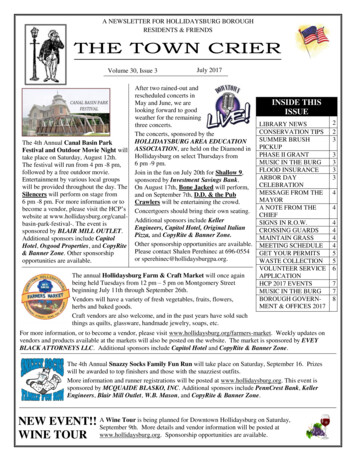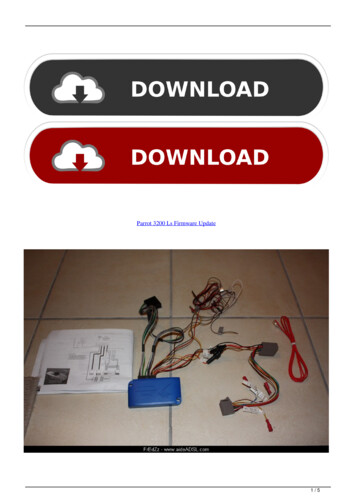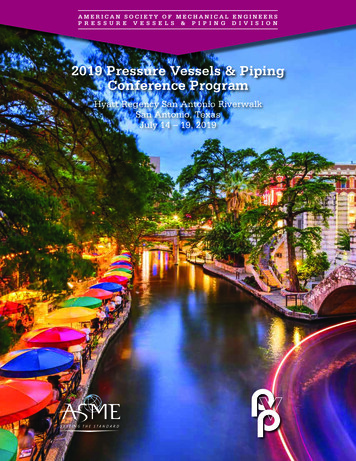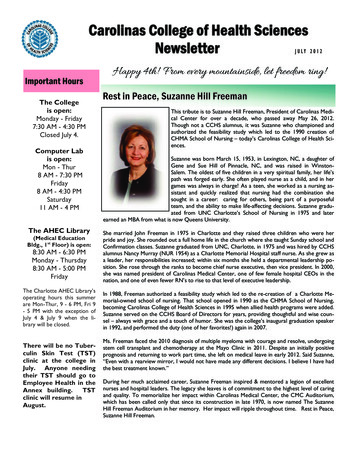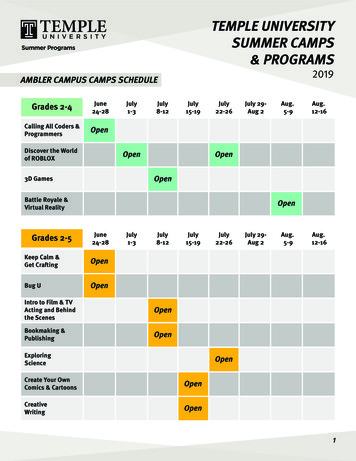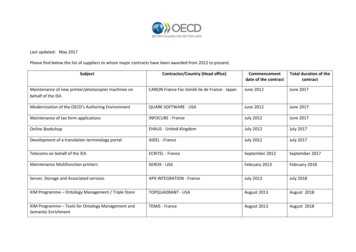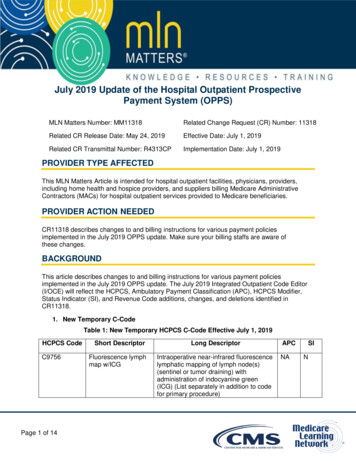
Transcription
Related CR ####July 2019 Update of the Hospital Outpatient ProspectivePayment System (OPPS)MLN Matters Number: MM11318Related Change Request (CR) Number: 11318Related CR Release Date: May 24, 2019Effective Date: July 1, 2019Related CR Transmittal Number: R4313CPImplementation Date: July 1, 2019PROVIDER TYPE AFFECTEDThis MLN Matters Article is intended for hospital outpatient facilities, physicians, providers,including home health and hospice providers, and suppliers billing Medicare AdministrativeContractors (MACs) for hospital outpatient services provided to Medicare beneficiaries.PROVIDER ACTION NEEDEDCR11318 describes changes to and billing instructions for various payment policiesimplemented in the July 2019 OPPS update. Make sure your billing staffs are aware ofthese changes.BACKGROUNDThis article describes changes to and billing instructions for various payment policiesimplemented in the July 2019 OPPS update. The July 2019 Integrated Outpatient Code Editor(I/OCE) will reflect the HCPCS, Ambulatory Payment Classification (APC), HCPCS Modifier,Status Indicator (SI), and Revenue Code additions, changes, and deletions identified inCR11318.1. New Temporary C-CodeTable 1: New Temporary HCPCS C-Code Effective July 1, 2019HCPCS CodeC9756Page 1 of 14Short DescriptorFluorescence lymphmap w/ICGLong DescriptorIntraoperative near-infrared fluorescencelymphatic mapping of lymph node(s)(sentinel or tumor draining) withadministration of indocyanine green(ICG) (List separately in addition to codefor primary procedure)APCNASIN
MLN Matters MM11318Related CR 113182. New CPT Category III Codes Effective July 1, 2019Similar to the vaccine codes, the American Medical Association (AMA) releases the CPTCategory III codes twice per year: in January, for implementation beginning the following July,and in July, for implementation beginning the following January.For the July 2019 update, the Centers for Medicare & Medicaid Services (CMS) is implementing20 CPT Category III codes that the AMA released in January 2019 for implementation on July 1,2019. The codes, their SIs and APC assignments are included in Table 2, below. Also added tothe July 2019 Addendum B, posted on the CMS website, effective July 1, 2019, are CPT codes0543T through 0562T. These codes were also added to the July I/OCE update. However,CPT codes 0559T and 0561T were added to the July I/OCE with status indicator “S”. Theirstatus indicators would be changed to status indicator “Q1” retroactive to July 1, 2019, inthe October I/OCE update.These codes, along with their short descriptors, SIs, and paymentrates (where applicable) are also listed in the July 2019 OPPS Addendum B that is available addendum-b-updates.html. For information onthe OPPS SIs, refer to OPPS Addendum D1 of the CY 2019 OPPS/ASC final rule for the latestdefinitions at icePayment/HospitalOutpatientPPS/index.html.Table 2. CPT Category III Codes Effective July 1, 2019CPT CodeLong DescriptorOPPSSI0543TTransapical mitral valve repair, including transthoracicechocardiography, when performed, with placement ofartificial chordae tendineaeC0544TTranscatheter mitral valve annulus reconstruction, withimplantation of adjustable annulus reconstruction device,percutaneous approach including transseptal punctureC0545TTranscatheter tricuspid valve annulus reconstruction withimplantation of adjustable annulus reconstruction device,percutaneous approachC0546TRadiofrequency spectroscopy, real time, intraoperativemargin assessment, at the time of partial mastectomy,with reportN0547TBone-material quality testing by microindentation(s) ofthe tibia(s), with results reported as a scoreE10548T*Transperineal periurethral balloon continence device;bilateral placement, including cystoscopy and fluoroscopyJ1Page 2 of 14OPPSAPC5377
MLN Matters MM11318CPT CodeRelated CR 11318Long DescriptorOPPSSIOPPSAPC0549TTransperineal periurethral balloon continence device;unilateral placement, including cystoscopy andfluoroscopyJ153750550TTransperineal periurethral balloon continence device;removal, each balloonJ153740551TTransperineal periurethral balloon continence device;adjustment of balloon(s) fluid volumeT53710552TLow-level laser therapy, dynamic photonic and dynamicthermokinetic energies, provided by a physician or otherqualified health care professionalM0553TPercutaneous transcatheter placement of iliacarteriovenous anastomosis implant, inclusive of allradiological supervision and interpretation,intraprocedural roadmapping, and imaging guidancenecessary to complete the interventionE10554TBone strength and fracture risk using finite elementanalysis of functional data, and bone-mineral density,utilizing data from a computed tomography scan; retrievaland transmission of the scan data, assessment of bonestrength and fracture risk and bone mineral density,interpretation and reportM0555TBone strength and fracture risk using finite elementanalysis of functional data, and bone-mineral density,utilizing data from a computed tomography scan; retrievaland transmission of the scan dataS57310556TBone strength and fracture risk using finite elementanalysis of functional data, and bone-mineral density,utilizing data from a computed tomography scan;assessment of bone strength and fracture risk and bonemineral densityBone strength and fracture risk using finite elementanalysis of functional data, and bone-mineral density,utilizing data from a computed tomography scan;interpretation and reportS55230557TPage 3 of 14M
MLN Matters MM11318CPT CodeRelated CR 11318Long DescriptorOPPSSIOPPSAPCS552157330558TComputed tomography scan taken for the purpose ofbiomechanical computed tomography analysis0559TAnatomic model 3D-printed from image data set(s); firstindividually prepared and processed component of ananatomic structureQ10560TAnatomic model 3D-printed from image data set(s); eachadditional individually prepared and processedcomponent of an anatomic structure (List separately inaddition to code for primary procedure)N0561TAnatomic guide 3D-printed and designed from imagedata set(s); first anatomic guideQ10562TAnatomic guide 3D-printed and designed from imagedata set(s); each additional anatomic guide (Listseparately in addition to code for primary procedure)N5733*HCPCS code C9746 (Transperineal implantation of permanent adjustable balloon continencedevice, with cystourethroscopy, when performed and/or fluoroscopy, when performed), whichwas effective July 1, 2017, was deleted June 30, 2019, and replaced with CPT code 0548Teffective July 1, 2019.3. CPT Proprietary Laboratory Analyses (PLA) Coding Changes EffectiveJuly 1, 2019The AMA CPT Editorial Panel deleted one PLA code, specifically, 0057U, and established 21new PLA codes, specifically, CPT codes 0084U through 0104U, effective July 1, 2019. Table 3,below, lists the long descriptors and SIs for the codes.For more information on OPPS status indicators “A,” “D,” “E1,” and “Q4”, refer to OPPSAddendum D1 of the Calendar Year 2019 OPPS/ASC final rule for the latest definitions. Addedto the July 2019 I/OCE are CPT codes 0084U through 0104U with an effective date of July 1,2019. These codes, along with their short descriptors and status indicators, are also listed in theJuly 2019 OPPS Addendum B.Page 4 of 14
MLN Matters MM11318Related CR 11318Table 3. PLA Coding Changes Effective July 1, 2019CPTCodeLong DescriptorOPPSSI0057UOncology (solid organ neoplasia), mrna, gene expressionprofiling by massively parallel sequencing for analysis of 51genes, utilizing formalin-fixed paraffin-embedded tissue,algorithm reported as a normalized percentile rankD0084URed blood cell antigen typing, DNA, genotyping of 10 bloodgroups with phenotype prediction of 37 red blood cellantigensA0085UCytolethal distending toxin B (CdtB) and vinculin IgGantibodies by immunoassay (ie, ELISA)0086UInfectious disease (bacterial and fungal), organismidentification, blood culture, using rRNA FISH, 6 or moreorganism targets, reported as positive or negative withphenotypic minimum inhibitory concentration (MIC)-basedantimicrobial susceptibilityA0087UCardiology (heart transplant), mRNA gene expressionprofiling by microarray of 1283 genes, transplant biopsytissue, allograft rejection and injury algorithm reported as aprobability scoreA0088UTransplantation medicine (kidney allograft rejection),microarray gene expression profiling of 1494 genes,utilizing transplant biopsy tissue, algorithm reported as aprobability score for rejectionA0089UOncology (melanoma), gene expression profiling byRTqPCR, PRAME and LINC00518, superficial collectionusing adhesive patch(es)Q40090UOncology (cutaneous melanoma), mRNA gene expressionprofiling by RT-PCR of 23 genes (14 content and 9housekeeping), utilizing formalin-fixed paraffin-embeddedtissue, algorithm reported as a categorical result (ie,benign, indeterminate, malignant)Oncology (colorectal) screening, cell enumeration ofcirculating tumor cells, utilizing whole blood, algorithm, forthe presence of adenoma or cancer, reported as a positiveor negative result0091UPage 5 of 14Q4AE1OPPSAPC
MLN Matters MM11318CPTCodeRelated CR 11318Long DescriptorOPPSSI0092UOncology (lung), three protein biomarkers, immunoassayusing magnetic nanosensor technology, plasma, algorithmreported as risk score for likelihood of malignancyQ40093UPrescription drug monitoring, evaluation of 65 commondrugs by LC-MS/MS, urine, each drug reported detected ornot detectedQ40094UGenome (eg, unexplained constitutional or heritabledisorder or syndrome), rapid sequence analysis0095UInflammation (eosinophilic esophagitis), ELISA analysis ofeotaxin-3 (CCL26 [C-C motif chemokine ligand 26]) andmajor basic protein (PRG2 [proteoglycan 2, pro eosinophilmajor basic protein]), specimen obtained by swallowednylon string, algorithm reported as predictive probabilityindex for active eosinophilic esophagitisQ40096UHuman papillomavirus (HPV), high-risk types (ie, 16, 18,31, 33, 35, 39, 45, 51, 52, 56, 58, 59, 66, 68), male urineQ40097UGastrointestinal pathogen, multiplex reverse transcriptionand multiplex amplified probe technique, multiple types orsubtypes, 22 targets (Campylobacter [C. jejuni/C. coli/C.upsaliensis], Clostridium difficile [C. difficile] toxin A/B,Plesiomonas shigelloides, Salmonella, Vibrio [V.parahaemolyticus/V. vulnificus/V. cholerae], includingspecific identification of Vibrio cholerae, Yersiniaenterocolitica, Enteroaggregative Escherichia coli [EAEC],Enteropathogenic Escherichia coli [EPEC], EnterotoxigenicEscherichia coli [ETEC] lt/st, Shiga-like toxin-producingEscherichia coli [STEC] stx1/stx2 [including specificidentification of the E. coli O157 serogroup within STEC],Shigella/Enteroinvasive Escherichia coli [EIEC],Cryptosporidium, Cyclospora cayetanensis, Entamoebahistolytica, Giardia lamblia [also known as G. intestinalisand G. duodenalis], adenovirus F 40/41, astrovirus,norovirus GI/GII, rotavirus A, sapovirus [Genogroups I, II,IV, and V])Q4Page 6 of 14AOPPSAPC
MLN Matters MM11318CPTCodeRelated CR 11318Long DescriptorOPPSSI0098URespiratory pathogen, multiplex reverse transcription andmultiplex amplified probe technique, multiple types orsubtypes, 14 targets (adenovirus, coronavirus, humanmetapneumovirus, influenza A, influenza A subtype H1,influenza A subtype H3, influenza A subtype H1-2009,influenza B, parainfluenza virus, humanrhinovirus/enterovirus, respiratory syncytial virus,Bordetella pertussis, Chlamydophila pneumoniae,Mycoplasma pneumoniae)Q40099URespiratory pathogen, multiplex reverse transcription andmultiplex amplified probe technique, multiple types orsubtypes, 20 targets (adenovirus, coronavirus 229E,coronavirus HKU1, coronavirus, coronavirus OC43, humanmetapneumovirus, influenza A, influenza A subtype,influenza A subtype H3, influenza A subtype H1-2009,influenza, parainfluenza virus, parainfluenza virus 2,parainfluenza virus 3, parainfluenza virus 4, humanrhinovirus/enterovirus, respiratory syncytial virus,Bordetella pertussis, Chlamydophila pneumonia,Mycoplasma pneumoniae)Q40100URespiratory pathogen, multiplex reverse transcription andmultiplex amplified probe technique, multiple types orsubtypes, 21 targets (adenovirus, coronavirus 229E,coronavirus HKU1, coronavirus NL63, coronavirus OC43,human metapneumovirus, human rhinovirus/enterovirus,influenza A, including subtypes H1, H1-2009, and H3,influenza B, parainfluenza virus 1, parainfluenza virus 2,parainfluenza virus 3, parainfluenza virus 4, respiratorysyncytial virus, Bordetella parapertussis [IS1001],Bordetella pertussis [ptxP], Chlamydia pneumoniae,Mycoplasma pneumoniae)Q40101UHereditary colon cancer disorders (eg, Lynch syndrome,PTEN hamartoma syndrome, Cowden syndrome, familialadenomatosis polyposis), genomic sequence analysispanel utilizing a combination of NGS, Sanger, MLPA, andarray CGH, with MRNA analytics to resolve variants ofunknown significance when indicated (15 genes[sequencing and deletion/duplication], EPCAM andGREM1 [deletion/duplication only])APage 7 of 14OPPSAPC
MLN Matters MM11318CPTCodeRelated CR 11318Long DescriptorOPPSSI0102UHereditary breast cancer-related disorders (eg, hereditarybreast cancer, hereditary ovarian cancer, hereditaryendometrial cancer), genomic sequence analysis panelutilizing a combination of NGS, Sanger, MLPA, and arrayCGH, with MRNA analytics to resolve variants of unknownsignificance when indicated (17 genes [sequencing anddeletion/duplication])A0103UHereditary ovarian cancer (eg, hereditary ovarian cancer,hereditary endometrial cancer), genomic sequenceanalysis panel utilizing a combination of NGS, Sanger,MLPA, and array CGH, with MRNA analytics to resolvevariants of unknown significance when indicated (24 genes[sequencing and deletion/duplication], EPCAM[deletion/duplication only])A0104UHereditary pan cancer (eg, hereditary breast and ovariancancer, hereditary endometrial cancer, hereditarycolorectal cancer), genomic sequence analysis panelutilizing a combination of NGS, Sanger, MLPA, and arrayCGH, with MRNA analytics to resolve variants of unknownsignificance when indicated (32 genes [sequencing anddeletion/duplication], EPCAM and GREM1[deletion/duplication only])AOPPSAPC4. Myocardial Imaging by Magnetocardiography (MCG)Currently, CPT codes 0541T and 0542T are SI “E1.” This indicates that the codes are not paidby Medicare, when submitted on outpatient claims (any outpatient bill type). On March 15, 2019,the device associated with these codes, specifically, the CardioFlux Magnetocardiogrpahy(MCG), received FDA approval. Consequently, CMS is revising the SIs for CPT codes 0541Tand 0542T. Specifically, CMS is re-assigning CPT code 0541T from “E1” to “S” (Procedure orService, Not Discounted When Multiple. Paid under OPPS; separate APC payment.) andassigning it to APC 5722 (Level 2 Diagnostic Tests and Related Services). Also, we are reassigning CPT code 0542T from “E1” to “M” (Items and Services Not Billable to the MAC, notpaid under OPPS.) effective July 1, 2019. The payment rate for CPT code 0541T is listed inAddendum B of the July 2019 OPPS Update that is posted on the CMS website. Listed in table4 below are CPT codes 0541T and 0542T and their status indicators.Page 8 of 14
MLN Matters MM11318Related CR 11318Table 4. CPT Category III Codes Effective July 1, 2019CPTCodeLong DescriptorOPPSSIOPPSAPC57220541TMyocardial imaging by magnetocardiography (mcg) fordetection of cardiac ischemia, by signal acquisition usingminimum 36 channel grid, generation of magnetic-field timeseries images, quantitative analysis of magnetic dipoles,machine learning-derived clinical scoring, and automatedreport generation, single study;S0542TMyocardial imaging by magnetocardiography (mcg) fordetection of cardiac ischemia, by signal acquisition usingminimum 36 channel grid, generation of magnetic-field timeseries images, quantitative analysis of magnetic dipoles,machine learning-derived clinical scoring, and automatedreport generation, single study; interpretation and reportM5. Drugs, Biologicals, and Radiopharmaceuticalsa. New HCPCS Codes and Dosage Descriptors for Certain Drugs, Biologicals, andRadiopharmaceuticalsFor July 2019, six new HCPCS codes have been created for reporting drugs andbiologicals in the hospital outpatient setting, where there have not previously beenspecific codes available. These new codes are listed in Table 5. Also, HCPCS codeQ5107 (Injection, bevacizumab-awwb, biosimilar, (mvasi), 10 mg) is currently not beingmarketed, so pricing information is not available for the July OPPS quarterly release.Once Q5107 is on the market, CMS will make pricing information available at thesoonest possible date on the OPPS payment files and payment will be retroactive to thedate the product is first available.Table 5. New HCPCS Codes for Certain Drugs, Biologicals, andRadiopharmaceuticals Effective July 1, 2019HCPCS CodeLong DescriptorSIAPCC9047Injection, caplacizumab-yhdp, 1 mgG9199C9048Dexamethasone, lacrimal ophthalmic insert, 0.1 mgG9308C9049Injection, tagraxofusp-erzs, 10 mcgG9309C9050Injection, emapalumab-lzsg, 1 mgG9310C9051Injection, omadacycline, 1 mgG9311Page 9 of 14
MLN Matters MM11318HCPCS CodeC9052Related CR 11318Long DescriptorSIAPCInjection, ravulizumab-cwvz, 10 mgG9312b. New Established HCPCS Codes for Separately Payable Drugs and Biologicalsas of July 1, 2019On July 1, 2019, nine new separately payable drug and biological HCPCS codes areestablished. Six of the codes are new codes. HCPCS code J9036 will replace HCPCScode C9042. Another HCPCS code J7208, will replace HCPCS code C9141. HCPCScode J9030 will replace HCPCS code J9031. The new codes are in Table 6. HCPCScodes C9042, C9141, and J9031 will be deleted effective June 30, 2019.Table 6. Other CY 2019 HCPCS and CPT Code Changes for Certain Drugs, Biologicals,and Radiopharmaceuticals Effective July 1, 2019NewHCPCSCodeOldHCPCSCodeLong DescriptorSIAPCJ9036C9042Injection, bendamustine hydrochloride,(Belrapzo/bendamustine), 1 mgG9313J7208C9141Injection, factor viii, (antihemophilic factor, recombinant),pegylated-aucl, (jivi), 1 i.u.G9299J1444Injection, ferric pyrophosphate citrate powder, 0.1 mg ofironNN/AJ9356Injection, trastuzumab, 10 mg and Hyaluronidase-oyskK9314Q5112Injection, trastuzumab-dttb, biosimilar, (Ontruzant), 10 mgE2N/AQ5113Injection, trastuzumab-pkrb, biosimilar, (Herzuma), 10 mgE2N/AQ5114Injection, Trastuzumab-dkst, biosimilar, (Ogivri), 10 mgE2N/AQ5115Injection, rituximab-abbs, biosimilar, (Truxima), 10 mgE2N/ABCG live intravesical instillation, 1 mgK0809J9030J9031c. Descriptor Change for the HCPCS code J9355, Effective July 1, 2019Effective July 1, 2019, the descriptors for the HCPCS code J9355 were updated. Pleasesee table 7.Page 10 of 14
MLN Matters MM11318Related CR 11318Table 7. Descriptor Change for the HCPCS code J9355, Effective July 1, 2019HCPCS CodeJ9355Old ShortDescriptorTrastuzumabinjectionNew ShortDescriptorInj trastuzumab exclbiosimiOld LongDescriptorInjection,trastuzumab, 10mgNew LongDescriptorInjection,trastuzumab, excludesbiosimilar, 10 mgd. Drugs and Biologicals with Payments Based on Average Sales Price (ASP)For CY 2019, payment for non-pass-through drugs, biologicals and therapeuticradiopharmaceuticals that were not acquired through the 340B Program is made at asingle rate of ASP 6 percent (or ASP - 22.5 percent if acquired under the 340BProgram), which provides payment for both the acquisition cost and pharmacy overheadcosts associated with the drug, biological or therapeutic radiopharmaceutical. In CY2019, a single payment of ASP 6 percent for pass-through drugs, biologicals andradiopharmaceuticals is made to provide payment for both the acquisition cost andpharmacy overhead costs of these pass-through items. CMS updates payments fordrugs and biologicals based on ASPs on a quarterly basis as later quarter ASPsubmissions become available. Effective July 1, 2019, payment rates for some drugsand biologicals have changed from the values published in the April 2019 update of theOPPS Addendum A and Addendum B found on the CMS web site. CMS is notpublishing the updated payment rates in this CR implementing the July 2019 update ofthe OPPS. However, the updated payment rates effective July 1, 2019, are in the July2019 update of the OPPS Addendum A and Addendum B athttp://www.cms.gov/HospitalOutpatientPPS/.e. Drugs and Biologicals Based on ASP Methodology with Restated PaymentRatesSome drugs and biologicals based on ASP methodology will have payment rates thatare corrected retroactively. These retroactive corrections typically occur on a quarterlybasis. The list of drugs and biologicals with corrected payments rates will be accessibleon the first date of the quarter at ment-Rates.html.Providers may resubmit claims that were impacted by adjustments to previous quarter’spayment files.6. Reassignment of Skin Substitute Products from the Low-Cost Group to the HighCost GroupOne skin substitute product, HCPCS code Q4176, was reassigned from the low-cost skinsubstitute group to the high-cost skin substitute group based on updated pricing information.The product is in Table 8.Page 11 of 14
MLN Matters MM11318Related CR 11318Table 8. – Reassignment of Skin Substitute Product from the Low-Cost Group to theHigh Cost Group Effective July 1, 2019CY 2019HCPCS CodeQ4176CY 2019 Short DescriptorNeopatch, per square centimeterCY 2019SILow/High CostSkin SubstituteNHigh7. New CPT Category I Vaccine Code Effective July 1, 2019The AMA releases CPT Category I vaccine codes twice per year: in January, forimplementation beginning the following July, and in July, for implementation beginning thefollowing January.For the July 2019 update, CMS is implementing one CPT Category I vaccine code that theAMA released in January 2019 for implementation on July 1, 2019. The SI for the code isshown in Table 9. For more information on the OPPS Status Indicator (SI) “E1,” refer toOPPS Addendum D1 of the CY 2019 OPPS/ASC final rule for the latest definitions. CPTcode 90619 is included in the July 2019 I/OCE with an effective date of July 1, 2019. CPTcode 90619, along with its short descriptor and status indicator, is also listed in the July2019 OPPS Addendum B.Table 9. CPT Category I Vaccine Code Effective July 1, 2019CPT CodeLong Descriptor90619Meningococcal conjugate vaccine, serogroups A, C,W, Y, quadrivalent, tetanus toxoid carrier (MenACWYTT), for intramuscular useOPPSSIOPPSAPCE18. Status Indicator Revision for CPT Code 90689Currently, CPT code 90689 has SI to “E1” to indicate that the vaccine is not payable byMedicare when submitted on outpatient claims (any outpatient bill type). However, as notedin Change Request 10871 (Quarterly Influenza Virus Vaccine Code Update - January 2019),Transmittal 4141, dated September 27, 2018, effective for claims with dates of service on orafter January 1, 2019, CPT 90689 will be payable by Medicare. Therefore, we are revisingthe SI from “E1” to “L” for CPT code 90689 to indicate that the vaccine will be “Paid atreasonable cost; not subject to deductible or coinsurance” retroactive to January 1, 2019.Refer to Table 10 for the code long descriptor and SI assignment. For more information onOPPS status indicators “E1” and “L”, refer to OPPS Addendum D1 of the Calendar Year2019 OPPS/ASC final rule for the latest definitions. To access transmittal 4141, refer ance/Transmittals/2018Downloads/R4141CP.pdf.Page 12 of 14
MLN Matters MM11318Related CR 11318Table 10. CPT Code 90689 Status Indicator RevisionCPT Code90689Long DescriptorInfluenza virus vaccine, quadrivalent (iiv4),inactivated, adjuvanted, preservative free, 0.25 mldosage, for intramuscular useOPPSSIOPPSAPCL9. Status Indicator Revision for HCPCS Code A4563Currently, A4563 is assigned to SI “N” (Paid under OPPS; payment is packaged intopayment for other services). Therefore, there is no separate APC payment. However, CMSis revising the SI to “A” (Not paid under OPPS but paid by MACs under a fee schedule orpayment system other than OPPS.) effective January 1, 2019. In the July 2019, I/OCEupdate since the code is separately payable under the Durable Medical Equipment,Prosthetics/Orthotics & Supplies (DMEPOS) Fee Schedule you may refer to Table 11 for thecode long descriptor and SI for HCPCS code A4563.CPT CodeA4563Table 11. HCPCS Code A4563 Status Indicator RevisionOPPSLong DescriptorSIRectal control system for vaginal insertion, for longterm use, includes pump and all supplies andaccessories, any type eachOPPSAPCA10. OPPS Pricer logic and data changes for JulyThere are no OPPS PRICER logic or data changes for July; therefore, there is no OPPSPRICER release for July.11. Coverage DeterminationsAs a reminder, the fact that a drug, device, procedure, or service is assigned a HCPCScode and a payment rate under the OPPS does not imply coverage by the Medicareprogram, but indicates only how the product, procedure, or service may be paid ifcovered by the program. Medicare Administrative Contractors (MACs) determinewhether a drug, device, procedure, or other service meets all program requirements forcoverage. For example, MACs determine that it is reasonable and necessary to treat thebeneficiary’s condition and whether or not it is payable.ADDITIONAL INFORMATIONThe official instruction, CR11318, issued to your MAC regarding this change is available ance/Transmittals/2019Downloads/R4313CP.pdf.Page 13 of 14
MLN Matters MM11318Related CR 11318If you have questions, your MACs may have more information. Find their website athttp://go.cms.gov/MAC-website-list.DOCUMENT HISTORYDate of ChangeMAY 30, 2019DescriptionInitial article released.Disclaimer: This article was prepared as a service to the public and is not intended to grant rights or impose obligations. This articlemay contain references or links to statutes, regulations, or other policy materials. The information provided is only intended to be ageneral summary. It is not intended to take the place of either the written law or regulations. We encourage readers to review thespecific statutes, regulations and other interpretive materials for a full and accurate statement of their contents. CPT only copyright2018 American Medical Association. All rights reserved.Copyright 2013-2019, the American Hospital Association, Chicago, Illinois. Reproduced by CMS with permission. No portion ofthe AHA copyrighted materials contained within this publication may be copied without the express written consent of the AHA. AHAcopyrighted materials including the UB-04 codes and descriptions may not be removed, copied, or utilized within any software,product, service, solution or derivative work without the written consent of the AHA. If an entity wishes to utilize any AHA materials,please contact the AHA at 312-893-6816. Making copies or utilizing the content of the UB-04 Manual, including the codes and/ordescriptions, for internal purposes, resale and/or to be used in any product or publication; creating any modified or derivative work ofthe UB-04 Manual and/or codes and descriptions; and/or making any commercial use of UB-04 Manual or any portion thereof,including the codes and/or descriptions, is only authorized with an express license from the American Hospital Association. Tolicense the electronic data file of UB-04 Data Specifications, contact Tim Carlson at (312) 893-6816. You may also contact us atub04@healthforum.comThe American Hospital Association (the “AHA”) has not reviewed, and is not responsible for, the completeness or accuracy of anyinformation contained in this material, nor was the AHA or any of its affiliates, involved in the preparation of this material, or theanalysis of information provided in the material. The views and/or positions presented in the material do not necessarily representthe views of the AHA. CMS and its products and services are not endorsed by the AHA or any of its affiliates.Page 14 of 14
Anatomic model 3D-printed from image data set(s); first individually prepared and processed component of an anatomic structure : Q1 . 5733 : 0560T . Anatomic model 3D-printed from image data set(s); each additional individually prepared and processed component of an anatomic structure (List separately in addition to code for primary procedure .



